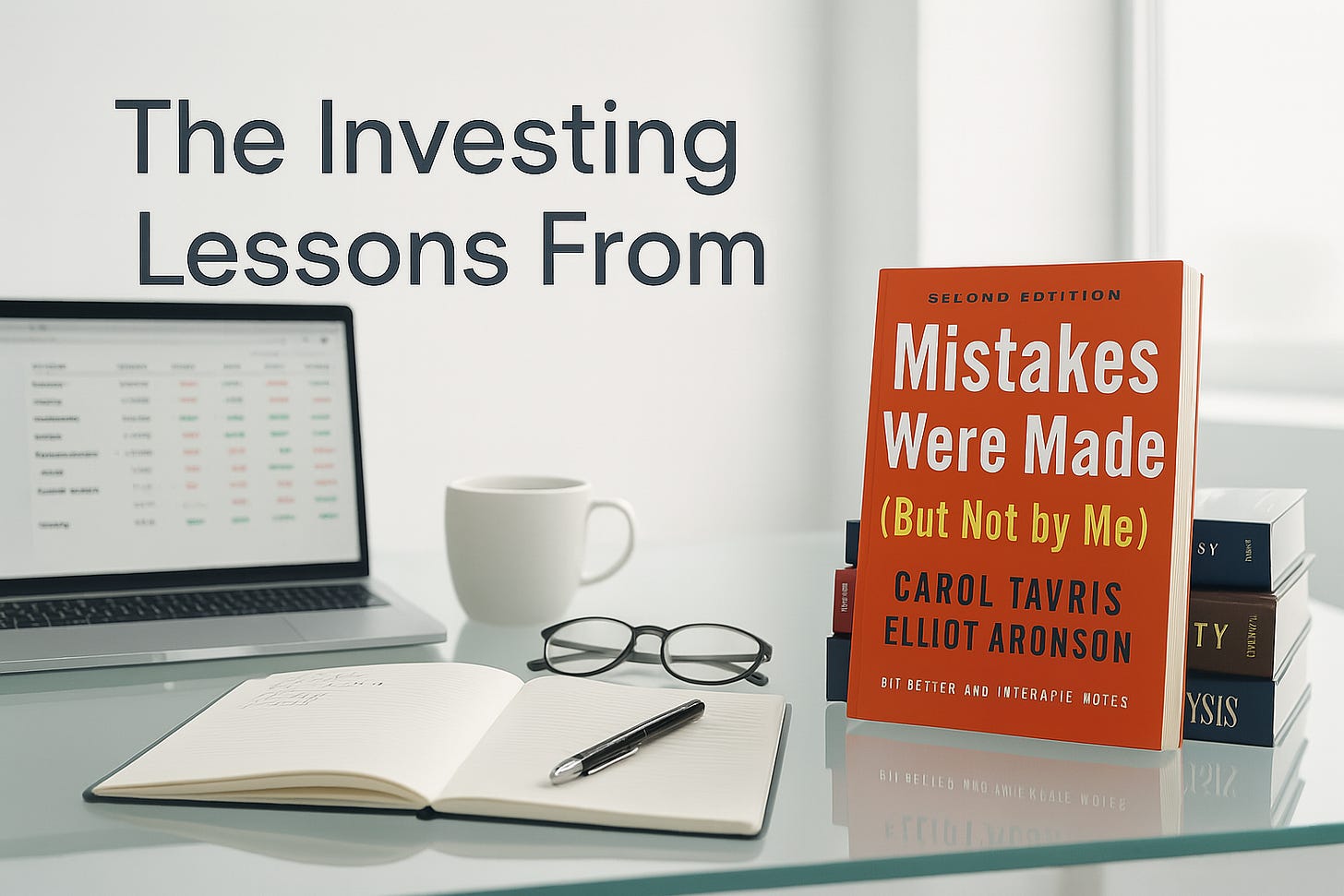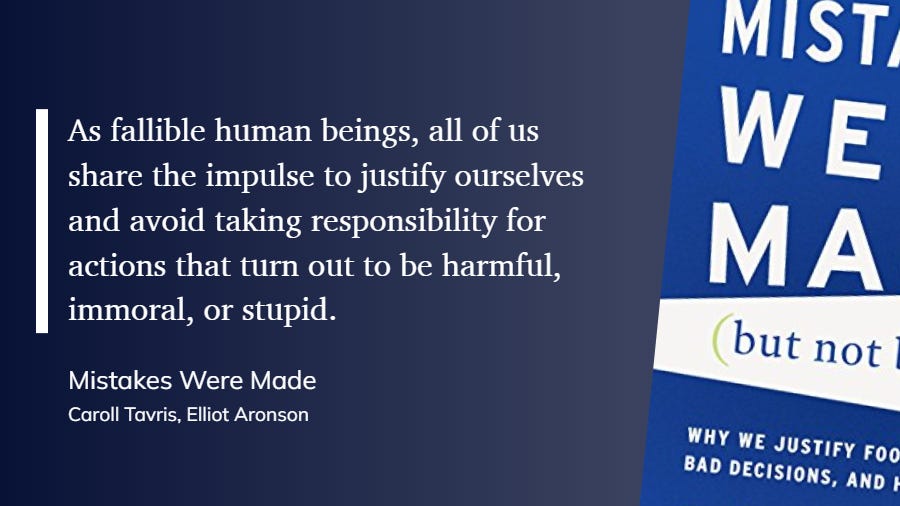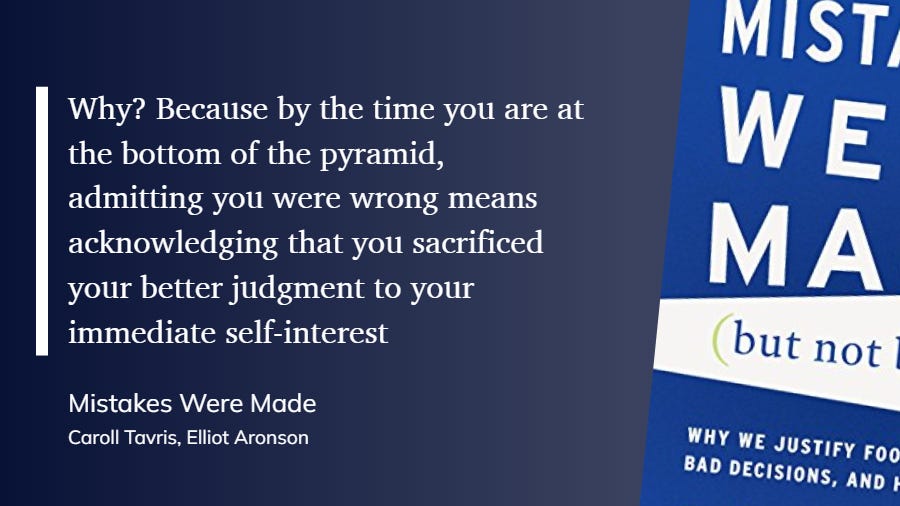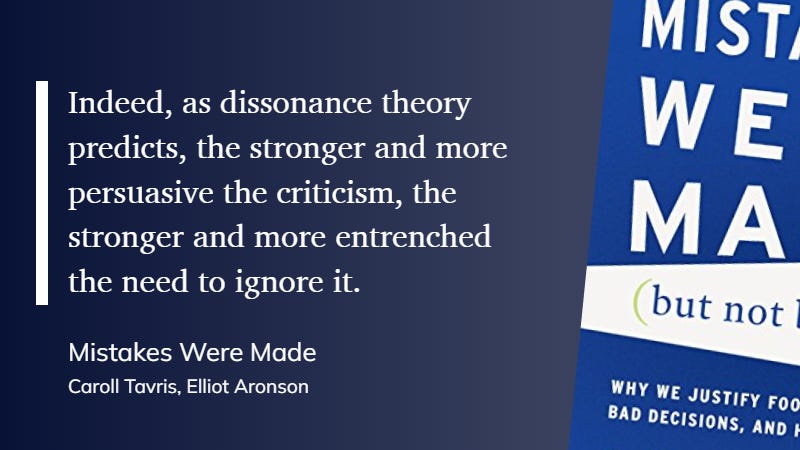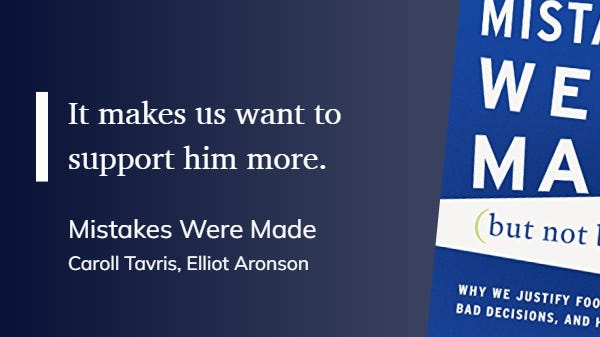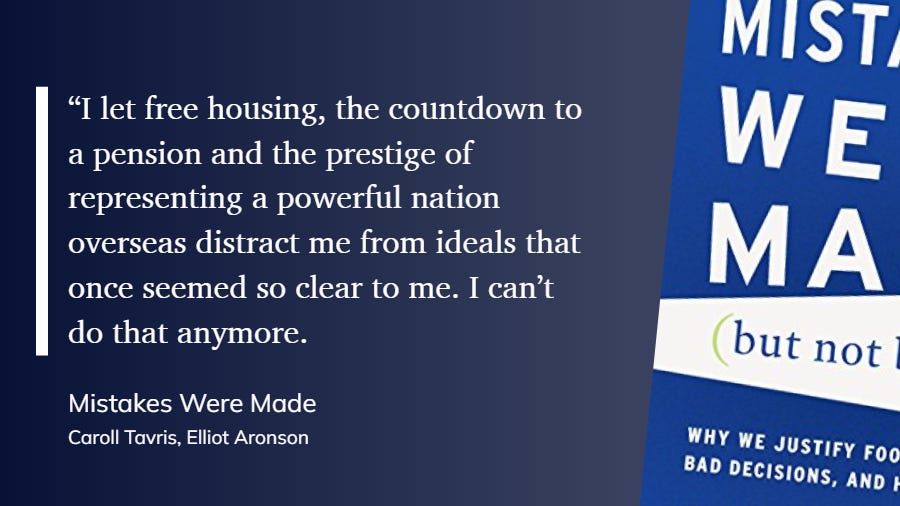Why Smart Investors Make Dumb Decisions (And How to Stop)
The investing lesson from Mistakes Were Made (But Not by Me)
The book Mistakes Were Made (But Not by Me) by Carol Tavris and Elliot Aronson offers profound insights into how cognitive dissonance shapes our decisions and justifications.
Though not specifically written about investing, the psychological principles explored in this work are remarkably applicable to how we manage our portfolios and make investment decisions.
Self-Justification: The Investor's Greatest Enemy
This fundamental insight explains why we hold onto losing stocks long after the evidence suggests we should sell.
The pain of admitting we made a mistake is often greater than the financial pain of watching our investment continue to deteriorate.
Consider what happens when you purchase a stock that subsequently drops 20%. Rather than reevaluating your thesis, you might find yourself looking for any positive news to justify your original decision. You ignore warning signs, rationalize negative earnings reports, and convince yourself that "the market just doesn't understand this company yet."
We’ve succumbed to Narrative Fallacy Framing Bias like the “Rabbits” in The Art of Execution.
This self-justification mechanism is particularly dangerous because it happens unconsciously. We genuinely believe our rationalizations rather than recognizing them as defensive maneuvers to protect our egos.
Breaking the Self-Justification Cycle
The first step is documentation.
Before making any significant investment, write down your thesis, including specific conditions that would prove your analysis wrong. Review this document regularly and honestly. When those conditions occur, commit to taking action regardless of your emotional attachment to the position.
Arrange for a trusted colleague or another investor to review your portfolio quarterly with the authority to question your justifications.
Consider implementing a "pre-commitment strategy." These are automatic kill criteria. This might involve setting automatic stop-loss orders or other rules that trigger an automatic sale if an event is triggered.
The Pyramid of Choice: How Small Compromises Lead to Major Mistakes
The investment world is filled with "pyramids of choice" where small initial compromises lead to increasingly problematic positions.
Think about what happens during a bull market. You might start with a well-diversified portfolio and clear investment criteria. Then you make an exception for an exciting stock that doesn't quite meet your standards. When that works out, you make another exception, then another. Before long, your carefully constructed investment discipline has eroded, leaving you vulnerable when market conditions change.
Each step down the pyramid makes it psychologically harder to admit the initial decision was flawed. The further down we go, the more we've invested, not just financially, but emotionally and intellectually in defending our choices.
Flattening the Pyramid
Again, writing down investment decisions provides a powerful defense against portfolio drift.
Documenting your investment thesis creates a clear record that makes rationalizing later deviations difficult. This documentation forces you to confront moments when you're making exceptions to your rules, often revealing when you're drifting from your principles. It serves as a reference to your original standards.
The "outside view" technique is imagining how you'd advise a friend in the same situation, and it helps bypass our psychological barriers.
We typically see flaws in others' reasoning more clearly than our own. This approach reveals justifications you're using to defend flawed positions, and the advice we give others is generally more objective than what we apply to ourselves.
The Confirmation Bias Paradox: When Evidence Strengthens Wrong Beliefs
This counterintuitive principle explains why presenting an investor with powerful evidence against their position often strengthens rather than weakens their conviction. The more threatening the information, the stronger the psychological need to discount it.
We see this regularly during market bubbles.
As valuation concerns mount and credible warnings increase, true believers become even more committed to their positions. The cognitive dissonance created by contradictory evidence is too painful to process, so they dismiss the messengers instead.
During the dotcom bubble, investors who questioned the "new paradigm" were labeled as dinosaurs who "didn't get it." During the housing bubble, warnings about unsustainable mortgage practices were dismissed as alarmist. In both cases, the strongest warnings often produced the strongest resistance.
Embracing Uncomfortable Evidence
The antidote to this is to deliberately seek out and seriously consider contradictory viewpoints.
For every investment you own, identify the smartest critic of that position and study their reasoning carefully. Don't automatically dismiss it.
Take a lesson from Charlie Munger,
I never allow myself to hold an opinion on anything that I don't know the other side's argument better than they do.
Can you create a well-crafted argument against your position? How can you know if a critic's contradictory viewpoint is flawed if you don't fully understand their point of view?
Create a "pre-mortem" for major positions.
Imagine your investment has failed one year from now. What happened?
This exercise helps surface potential problems while you still have time to address them or exit the position. Preparing yourself in advance makes you more receptive to this information when it eventually surfaces.
Identity-Based Investing: When Positions Become Personal
Though this quote refers to political loyalty when confronted with their preferred candidate's character and moral flaws, it illustrates how criticism of something we identify with personally strengthens rather than weakens our commitment.
This happens frequently in investing when we tie our identity to particular investment styles, sectors, or even specific companies.
It’s very similar to the confirmation bias, but slightly different since it is more about our identity than about being “right” about an individual stock.
Value investors, growth investors, dividend investors, technical analysts – these approaches can become core parts of our professional identities. When our chosen approach underperforms, we often respond not by questioning our methods but by doubling down on them.
Separating Identity from Strategy
Remember that investment approaches are tools, not identities.
The most successful investors adapt their strategies to changing market conditions rather than rigidly adhering to a single approach in all environments.
We want to practice intellectual flexibility and explore other investment ideas that fall outside our usual comfort zone. This builds the mental muscles necessary to adjust or adapt our primary investment strategy as market conditions change.
The Wisdom of Acknowledging Mistakes
This whistleblower's quote reminds us that recognizing and acknowledging our mistakes, while painful in the short term, ultimately liberates us to make better decisions moving forward.
The truly successful investor is not one who never errs, but one who learns quickly and adapts when errors occur.
By understanding how cognitive dissonance shapes our financial decisions, we can build safeguards against our most damaging biases.
Remember that the goal is not perfection but improvement.
Each time you recognize a bias in your investment thinking and take steps to counter it, you strengthen your decision-making muscles. Over time, this process of continuous improvement will compound.


